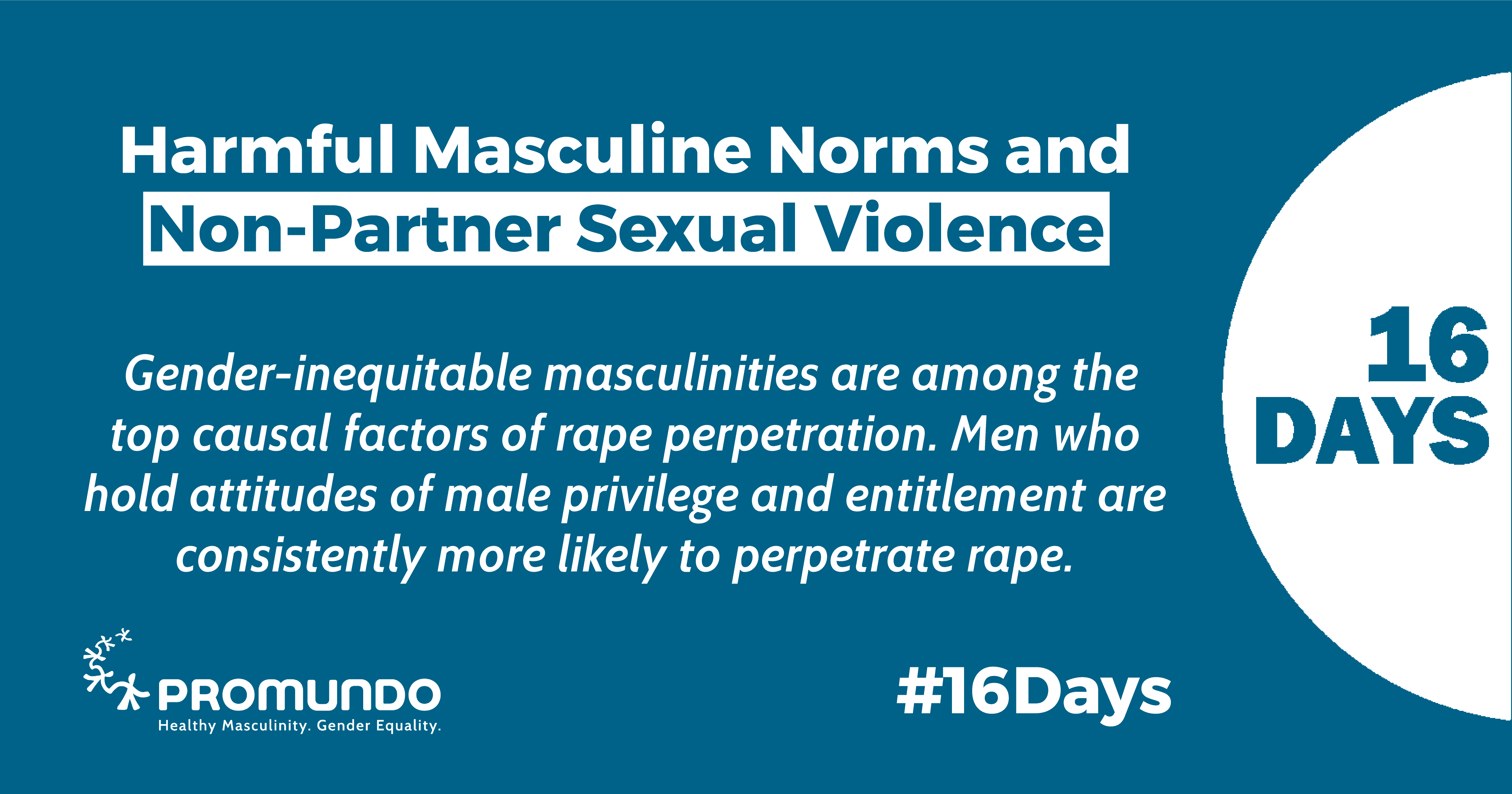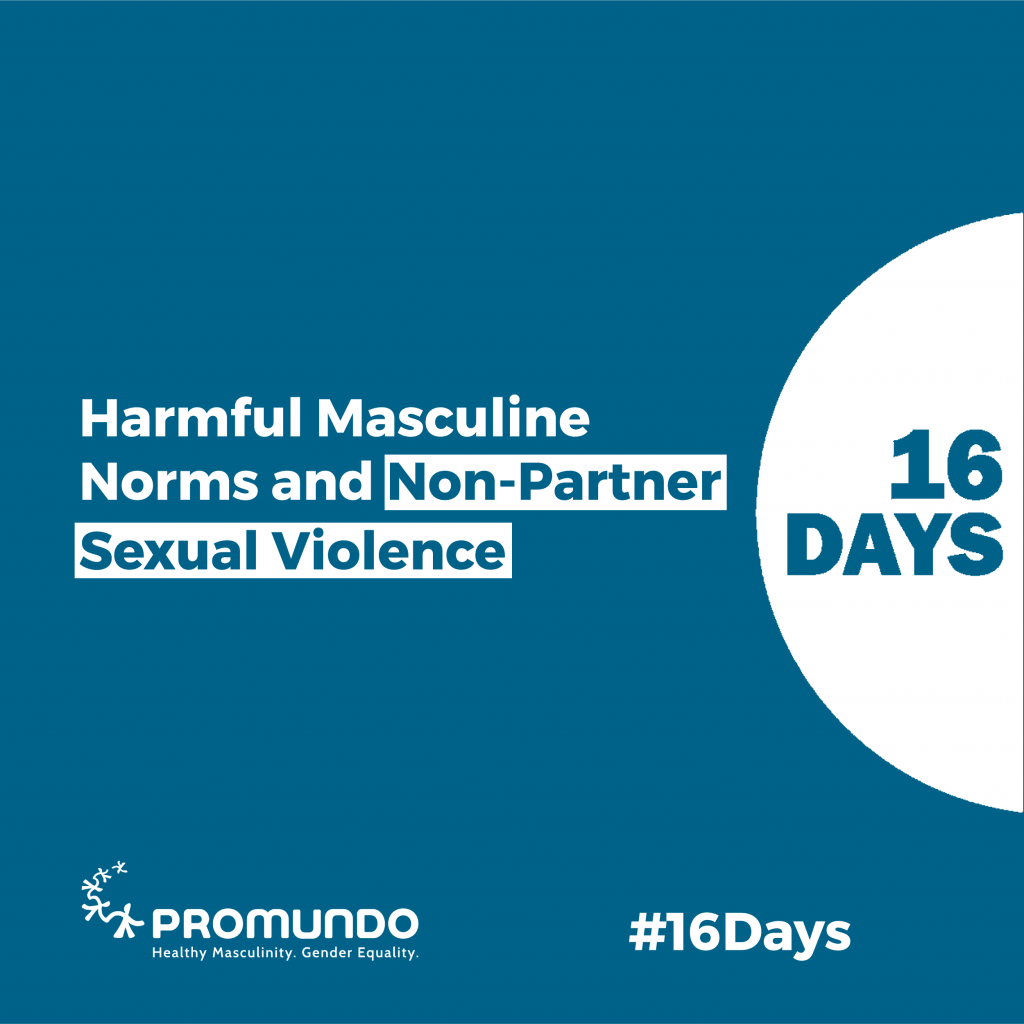Les 16 jours d’activisme contre la violence sexiste sont une campagne internationale utilisée par des militants du monde entier (du 25 novembre au 10 décembre) comme stratégie d’organisation pour appeler à l’élimination de toutes les formes de violence sexiste.
Cette année, nous partagerons des recherches sur les liens entre les normes masculines néfastes et huit formes différentes de comportement violent, ainsi que des idées et des recommandations pour éliminer toutes les formes de violence.

Même si le fait d’être un homme n’a rien d’inhérent à la violence, la manière dont nous socialisons les garçons dans leur identité d’homme et ce que nous attendons d’eux – c’est-à-dire les normes masculines de la société – sont indéniablement liés à la violence.
En effet, les garçons et les hommes sont souvent élevés, socialisés et encouragés à recourir à la violence sous une forme ou une autre ; dans l’ensemble, ils sont plus susceptibles de commettre la plupart des formes de violence et de mourir par homicide ou suicide. Cependant, les recherches confirment que cette violence est évitable, que l’égalité des sexes est réalisable et que les normes et idées non violentes sur la virilité sont répandues et puissantes.
Rapport d'Equimundo et de la Fondation Oak Normes masculines et violence : établir des liens, examine les liens entre les normes masculines néfastes et huit formes de comportement violent. Ce sixième blogue de la Établir les connexions16 jours d'activisme La série se concentre sur les violences sexuelles entre personnes non partenaires. Elle analyse les faits sur ces violences, explore leurs liens avec d'autres formes de violence et propose des recommandations d'action.
Violence sexuelle entre personnes non partenaires
Les faits
Il existe diverses formes de violence sexuelle hors du partenaire, telles que le harcèlement sexuel verbal, les attouchements sexuels non désirés et le viol. Ces violences sont principalement perpétrées par des hommes contre des femmes et des filles, bien que de plus en plus de données fassent état de violences sexuelles importantes commises par des hommes contre d'autres hommes et contre des garçons.
L'OMS estime que 7 % des femmes dans le monde ont été agressées sexuellement par une personne autre que leur partenaire (chiffre qui exclut le harcèlement sexuel). Les formes de violence sexuelle autres que les rapports sexuels forcés, notamment le harcèlement sexuel de rue, sont courantes. Selon ActionAid, 79 % des femmes vivant dans les villes en Inde et 89 % au Brésil ont été victimes de harcèlement sexuel ou de violence en public, tout comme 75 % des femmes à Londres.. Par conséquent, les hommes sont considérablement plus susceptibles que les femmes de dire qu’ils se sentent en sécurité lorsqu’ils marchent seuls la nuit dans leur communauté, selon les données de 143 pays.
La violence sexuelle contre les hommes et les garçons est largement sous-déclarée, en grande partie en raison des idées normatives sur la masculinité, des stéréotypes sexistes et de la stigmatisation qui en résulte en tant qu’homme survivant de violences sexuelles.
Les liens
Les masculinités inégales entre les sexes figurent parmi les principaux facteurs causaux de viol, selon une synthèse de 2012 d'environ 300 études qualifiées. De même, données IMAGES Des études menées dans cinq pays démontrent que les hommes qui ont des attitudes de privilège et de droit masculins sont systématiquement plus susceptibles de commettre des viols.
La violence sexuelle peut servir d'outil aux hommes et aux garçons pour prouver leur virilité, accéder au statut social d'« homme véritable » et asseoir leur pouvoir et leur contrôle sur les autres. Elle peut également servir à contrôler la performance de genre des individus, quelle que soit leur identité de genre.
L'éventail d'attitudes culturelles marquantes qui sous-tendent les violences sexuelles masculines – y compris les normes masculines néfastes – est si répandu, à l'échelle mondiale et locale, que les chercheuses féministes et les critiques culturelles ont forgé le terme de « culture du viol » pour la décrire. De plus, cette culture du viol culpabilise la personne agressée et rend invisible la dynamique culturelle qui crée un environnement propice aux violences sexuelles.
Les intersections
Comme pour d’autres formes de violence, le fait d’avoir subi des violences durant l’enfance est lié à une probabilité nettement plus élevée que les hommes commettent des violences sexuelles à l’âge adulte.
Les données mondiales suggèrent des relations complexes et multidirectionnelles entre le niveau d’éducation, le niveau de revenu et la perpétration de violences sexuelles, ce qui rend impossible toute généralisation.
Outre les expositions néfastes durant l’enfance et les masculinités inégales entre les sexes, la recherche identifie trois autres facteurs de risque majeurs de perpétration de viol : les troubles de l’attachement et de la personnalité, l’apprentissage social et la délinquance, ainsi que la toxicomanie et l’accès aux armes à feu.
De la théorie à la pratique
Les initiatives visant à prévenir la violence sexuelle entre personnes non partenaires devraient se concentrer sur les transformations suivantes des normes masculines néfastes :
- Demandez aux participants de nommer et d’identifier les effets néfastes des normes de genre sur les individus de toutes les identités de genre, en particulier en ce qui concerne l’expression de genre et la sexualité.
- Encourager la discussion et l’appréciation des masculinités alternatives qui offrent des idées saines et non violentes de la virilité.
- Identifier la culture du viol et engager les participants dans une exploration de la manière dont elle se manifeste, de ses conséquences négatives et de la manière de la changer (en encourageant le plaidoyer).
- Démontrer les effets néfastes et étendus de la violence sexuelle, y compris les effets intergénérationnels, et insister sur le fait que la violence sexuelle n’est jamais justifiée.
- Reconnaître que le soutien psychosocial est particulièrement important pour aider à perturber les cycles intergénérationnels de violence chez les jeunes qui ont subi ou été témoins de violence pendant leur enfance.
